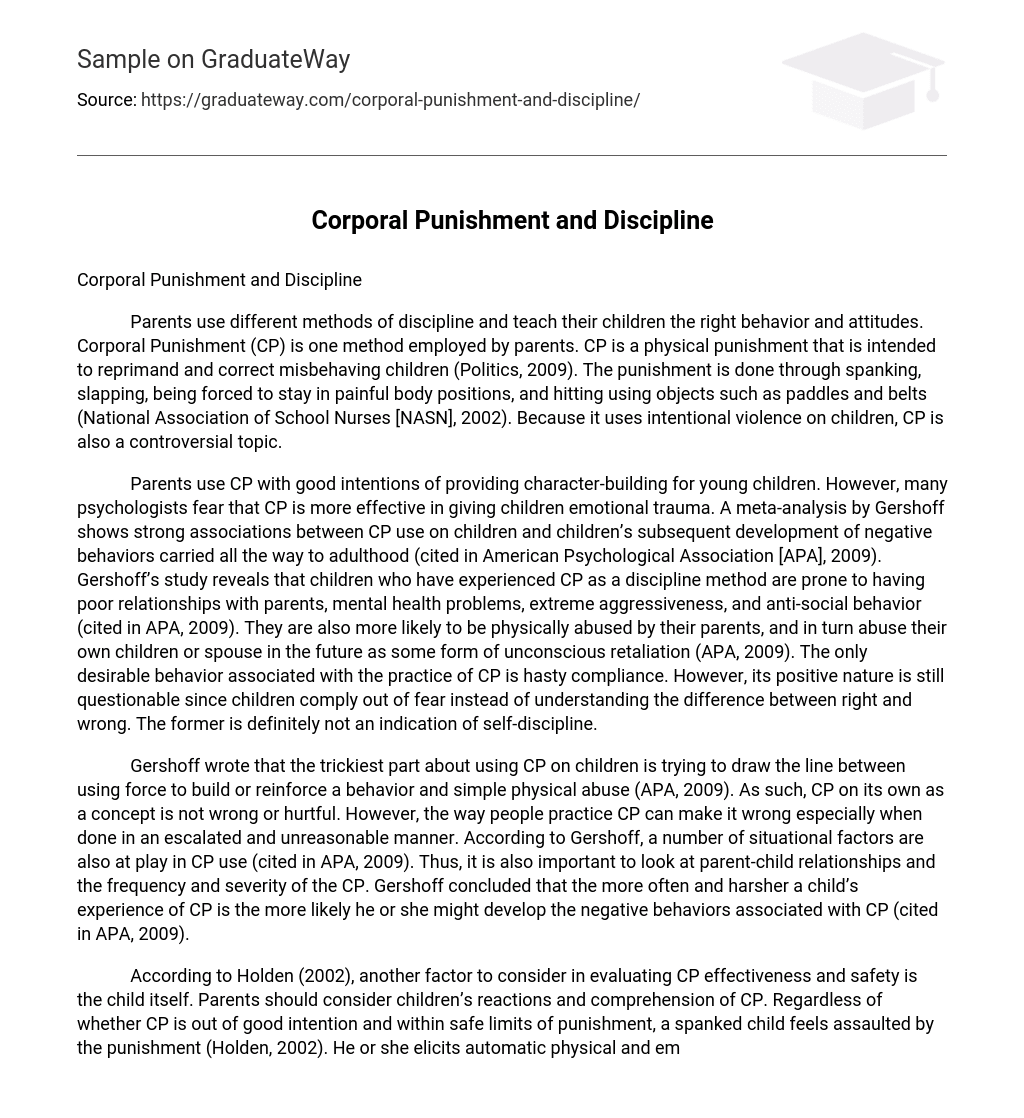Parents use different methods of discipline and teach their children the right behavior and attitudes. Corporal Punishment (CP) is one method employed by parents. CP is a physical punishment that is intended to reprimand and correct misbehaving children (Politics, 2009). The punishment is done through spanking, slapping, being forced to stay in painful body positions, and hitting using objects such as paddles and belts (National Association of School Nurses [NASN], 2002). Because it uses intentional violence on children, CP is also a controversial topic.
Parents use CP with good intentions of providing character-building for young children. However, many psychologists fear that CP is more effective in giving children emotional trauma. A meta-analysis by Gershoff shows strong associations between CP use on children and children’s subsequent development of negative behaviors carried all the way to adulthood (cited in American Psychological Association [APA], 2009). Gershoff’s study reveals that children who have experienced CP as a discipline method are prone to having poor relationships with parents, mental health problems, extreme aggressiveness, and anti-social behavior (cited in APA, 2009). They are also more likely to be physically abused by their parents, and in turn abuse their own children or spouse in the future as some form of unconscious retaliation (APA, 2009). The only desirable behavior associated with the practice of CP is hasty compliance. However, its positive nature is still questionable since children comply out of fear instead of understanding the difference between right and wrong. The former is definitely not an indication of self-discipline.
Gershoff wrote that the trickiest part about using CP on children is trying to draw the line between using force to build or reinforce a behavior and simple physical abuse (APA, 2009). As such, CP on its own as a concept is not wrong or hurtful. However, the way people practice CP can make it wrong especially when done in an escalated and unreasonable manner. According to Gershoff, a number of situational factors are also at play in CP use (cited in APA, 2009). Thus, it is also important to look at parent-child relationships and the frequency and severity of the CP. Gershoff concluded that the more often and harsher a child’s experience of CP is the more likely he or she might develop the negative behaviors associated with CP (cited in APA, 2009).
According to Holden (2002), another factor to consider in evaluating CP effectiveness and safety is the child itself. Parents should consider children’s reactions and comprehension of CP. Regardless of whether CP is out of good intention and within safe limits of punishment, a spanked child feels assaulted by the punishment (Holden, 2002). He or she elicits automatic physical and emotional response to the pain. The physical arousal and negative emotion can alter how children perceive the pain inflicted by his or her own parents (Holden, 2002). Therefore, it is very important that a parent combines CP with a talk about why the spanking happened so as to facilitate the child’s understanding and acceptance of the disciplinary method.
The behavioral disorders CP might cause diminish its desirability and effectiveness as a discipline method. Another liability is CP’s seeming incompleteness as a disciplinary technique. Gershoff explained that children might only behave well when there is a threat of physical punishment and revert to misbehaving when the threat, i.e. their parents, is not around (cited in APA, 2009). Another problem is that CP by itself does not teach the child what is right and wrong. It simply judges and punishes without any explanation. Hence, without explaining to the child why physical punishment was necessary, the child simply feels assaulted and alienated from his or her parents, the people who ought to love him or her the most. This increases the chances for the emotional estrangement and personality disorder. As such, parents who want to discipline their children should employ other forms of parenting discipline. They should use CP only as a last resort and always with a supporting explanation.
There are more positive ways of guiding children to learn good conduct. Parents should refrain from relying on CP as a disciplinary method. Rather than waiting to punish children when they do something wrong, Natrajan and Myers-Walls (2006) suggest that it is better to prevent the misbehavior by setting a good example from the beginning. When parents are models of good behavior, their children instinctively imitate and follow them. Further, parents should try to talk to the children first and find out the cause of the misbehavior instead of immediately punishing them. Another factor to help discipline children is by providing positive reinforcement to those who deserve it at successive approximations (Natrajan & Myers-Walls, 2006).
Corporal punishment is an incomplete disciplinary method. Though its threat may give immediate compliance, children who experience the punishment are unable to understand the reason for such violent punishment. Children may carry the hurt and confusion through to their adulthood as personality disorders. Thus, it is more effective and desirable to use reinforcement and modeling methods to guide and discipline children to proper behaviors.
References
American Psychological Association. (2002, June 26). Is corporal punishment an effective means of discipline?. APA Online. Retrieved February 26, 2009 from http://www.apa.org/releases/spanking.html.
Holden, G. W. (2002). Perspectives on the effects of corporal punishment: Comment on Gershoff (2002). Psychological Bulletin, 128 (4), 590-595. doi: 10.1037//0033-2909.128.4.590.
National Association of School Nurses. (2002, June). Position statement: Corporal punishment in schools. Retrieved February 26, 2009 from http://www.nasn.org/Default.aspx?tabid=214.
Natrajan, R. & Myers-Walls, J. A. (2006). Making discipline positive. Purdue University. Retrieved February 26, 2009 from http://www.ces.purdue.edu/providerparent/Guidance-Discipline/MakingDiscPositive.htm.
Politics. (2009, Feb. 26). Corporal punishment. Politics.co.uk. Retrieved February 26, 2009 from
http://www.politics.co.uk/briefings-guides/issue-briefs/education/schools/corporal-punishment/corporal-punishment-$366656.htm.





